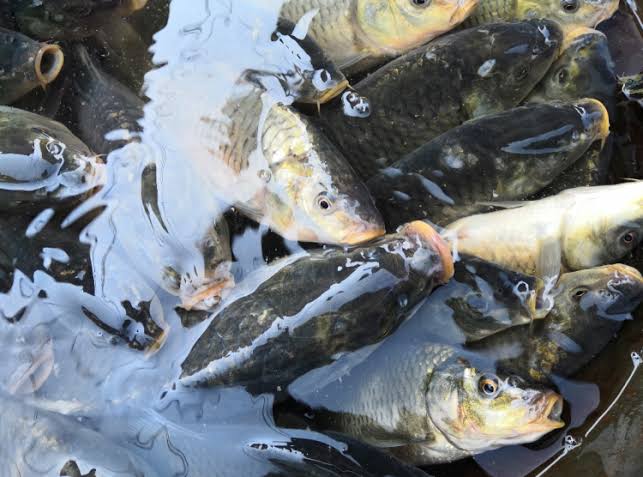Jammu: Jammu & Kashmir has abundant water resources and great potential for fish and fisheries development. However, due to some challenges like outdated infrastructure, inbreeding depression, limited variety of aquaculture species, fragile aquatic ecosystems and lack of modern aquaculture technologies, the Fish farming was not progressing.
Now, to overcome these challenges and make Fish farming a prosperous sector, the UT government has approved a Rs. 176 crore project to boost fish production. The project involves importing genetically improved fish seed, upgrading existing hatcheries and fish rearing units, introducing species diversity in aquaculture through R&D, and commercializing trout and carp fish production using modern technologies such as RAS and Biofloc.
Additional Chief Secretary (ACS), Agriculture Production Department (APD), Atal Dulloo, who leads the Agriculture Production Department of J&K, said that the aim of the project is to promote sustainable development of fisheries for nutritional security, employment generation, and economic prosperity in the UT of J&K. The programme aims to increase fish production, productivity, and growth rate, as well as to strengthen social security and welfare measures for the fishing community, facilitate improved post-harvest practices and value addition, and create market linkages, he added.
“One of the prime requisites for successful aquaculture is the availability of good quality fish seed. The Technical Programme under the project includes importing genetically improved varieties of fish seed to ensure the overall success of fish farming practices. Quality fish seed determines the health, size, growth rate, disease resistance, and other physical and physiological characteristics of the fish, which in turn affect the overall fish production”, Dulloo said.
The ACS further remarked that in addition to importing genetically improved fish seed, the Technical Programme also aims to establish new hatchery units and upgrade existing ones on modern scientific lines. This will improve the quality and quantity of fish seed available for fish farming, and enable the production of a more diverse range of aquaculture species, he added.
Notably, under the programme, the UT government also plans to establish 10 new trout hatcheries and two carp hatcheries, and upgrade 8 carp and 10 trout units. ‘Technological Interventions for Fish Seed and Trout Production in UT of J&K’ is one among the 29 projects, which were approved by the Jammu and Kashmir administration after being recommended by the UT Level Apex Committee for holistic development of Agriculture and Allied Sectors in UT of J&K.
The prestigious committee is headed by Dr Mangala Rai, Former DG ICAR and has other luminaries in the field of Agriculture, Planning, Statistics & Administration like Ashok Dalwai, CEO NRAA; Dr. P. K Joshi, Secretary, NAAS; Dr. Prabhat Kumar, Horticulture Commissioner MOA & FW; Dr. H. S Gupta, Former Director, IARI; Additional Chief Secretary, Agriculture Production Department, J&K, Atal Dulloo, apart from the Vice Chancellors of the twin Agriculture Universities of the UT.
The project also includes introducing species diversity in aquaculture through research and development (R&D). The UT government recognizes that a limited variety of aquaculture species is a challenge to the sector, and aims to address this through R&D. The programme will develop and introduce new species of fish for aquaculture, which will not only enhance the variety of fish available for farming, but also reduce the risks of inbreeding depression.
To commercialize the trout/carp fish production, modern technologies like RAS/Biofloc will be introduced at a large scale. These technologies will ensure that the fish are raised in a controlled and optimal environment, which will increase their growth rate and size. RAS (Recirculating Aquaculture System) technology involves the reuse of water by removing waste and re-oxygenating the water, making it a more sustainable and eco-friendly option for fish farming. Biofloc technology is a culture system that involves the conversion of waste into protein-rich feed for fish, which reduces the cost of feed ingredients and promotes sustainable fish farming.
The Technical Programme aims to revolutionize fish farming in the UT of J&K with ambitious targets for fisheries development. The program seeks to increase annual trout production by 2.5 times, from 1,663 to 4,000 tonnes, and add an additional 1,200 tonnes of carps every year. By doing so, the program intends to convert the current import of around 5,000 tonnes of fish from other regions into local commerce, generating 6,050 jobs and 150 enterprises. The program also aims to boost the growth rate of the fish sector from 3.28% to 40%, and increase revenue from INR 105.55 crores to INR 589 crores per year.
The successful implementation of the project will not only promote sustainable development of fisheries but also contribute to nutritional security, employment generation, and economic prosperity in the UT of J&K. It will also strengthen social security and welfare measures for the fishing community, by ensuring that the benefits of the programme reach the grassroots level. The Technical Programme has been designed to address the challenges faced by the sector, and provide a comprehensive solution to improve fish and fisheries development in the UT of J&K. By leveraging modern technologies, R&D, and market linkages, the programme aims to create a self-sustaining and vibrant aquaculture industry in the region.
The success of the project will not only benefit the fishing community and the aquaculture industry, but also contribute to the larger goal of sustainable development in the region. The programme will enhance the availability of nutritious and affordable fish for the local population, which will improve their food security and nutrition. It will also create job opportunities and boost the local economy, which will contribute to the overall development of the region. The UT government’s initiative to promote fish and fisheries development through technological interventions is a step in the right direction, and it is hoped that it will serve as a model for other regions to follow.











